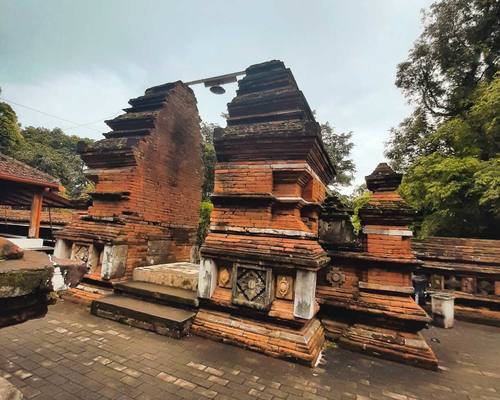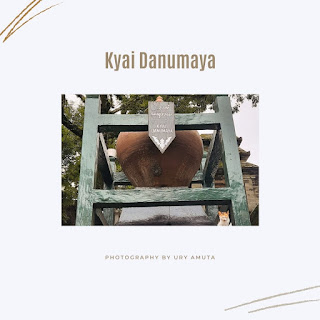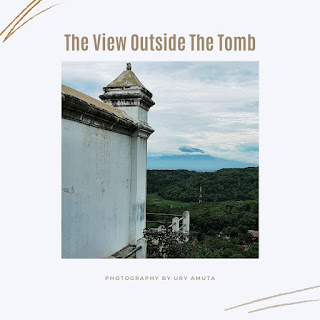History of Pasarean Imogiri Mataram
Table Of Contents

1. Introduction

Igot information about the funeral of the kings in Imogiri from a relative who lives in the city of Yogyakarta, at that time we were on pilgrimage to the burial of my relative's parents and they accidentally discussed the grave which is not too far from the residents' public cemetery.
Quoted from the official website of kratojogja.id, it explains that Imogiri Tomb, or Pasarean Imogiri, is the final resting location for the Kings of Mataram and their families. This burial complex is located approximately 16 km to the south of the Yogyakarta Palace, precisely in the areas of Girirejo Village and Wukirsari Village, Imogiri District, Bantul Regency, Yogyakarta Special Region. Imogiri comes from the words hima and giri. Hima means “fog” and giri means “mountain”, so Imogiri can be interpreted as “a mountain shrouded in fog”. The choice of hills as the location of the graves cannot be separated from the concept of the pre-Hindu Javanese society who saw hills, or high places, as a sacred place and a place for ancestral spirits to reside. In addition, choosing a location in a high place is also a form of Hindu belief that the higher the burial place, the higher the degree of glory.
Before visiting, I did not have any description about the tomb of the king of Imogiri and it made me curious and wanted to go there immediately but several times failed due to other urgent needs as I wrote on my profile that I moved here to continue my studies and have to prioritize it.
Finally, in early January I was able to visit there, but it was unfortunate that upon arrival the cemetery was closed for pilgrims and could only look at the burial area which was approximately 10 hectares according to some information.
2. The History Of Pasarean Imogiri Mataram
A brief history of the early establishment of the Pasarean Imogiri as quoted from the official website of kratonjogja.id explains that Pasarean Imogiri was built in 1632, during the reign of Sultan Agung Hanyakrakusuma (1613-1645). The construction of the tomb complex was led by Kiai Tumenggung Citrokusumo, the architecture is a blend of Hinduism and Islam. The red brick that dominates the upper tomb area is the main feature of Javanese Islamic architecture or Hindu Islamic architecture in the 17th century. The bricks that make up the Pasarean Imogiri building are not glued together using special material such as cement. It is suspected that the bricks were arranged using the Kosod method. The surface of the brick is rubbed against the surface of the other brick with a little water until it comes out a kind of thick liquid. This thick liquid then attaches one brick to another. This method was made possible because of the special mixture in the bricks of that time which are no longer present in modern bricks.
The best time to visit is recommended at 10.00 am in the morning except on Friday, at 01.00 pm, to be able to enter and visit the tombs of the kings, and the unique thing is that we have to climb more than 400 steps, but every information circulating, the count number of steps is always has different numbers on every counters, some say 408, 420, 411 etc.
 |
| Stairs with more than 400 in total |
Quoted from wikipedia Indonesia, explains that before entering the king's tomb, there are many steps about 4 meters wide with a 45-degree slope that connects the settlement with the tomb. There are 409 steps in the Pasarean Imogiri.
According to a myth that is believed by some people, if a visitor is able to count the number of stairs correctly, all his wishes will come true.
Some steps have a specific meaning, namely:
- There are 32 steps from the settlement to the area near the mosque. The number of steps indicates that the Pasarean Imogiri was built in 1632.
- There are 13 steps from the area near the mosque to the mosque yard. This number of steps symbolizes that Sultan Agung was appointed king of Mataram in 1613.
- There are 45 steps from the courtyard of the mosque to the longest ladder. The number of stairs symbolizes that Sultan Agung died in 1645.
- The longest rung is 346 steps. The number of stairs indicates that the Pasarean Imogiri was built for 346 years.
- There are 9 steps around the pool. The number of steps represents Walisongo.
3. Tomb Area
When stepping the stairs, we will meet many local people who sell 3 small books containing maps of the Pasarean Imogiri, a brief history of the Mataram kings and the Pasarean Kota Gede, because it was too late so I only met one seller who was already going home. The price of 3 books is IDR 20,000, we can buy it or not. To be able to enter the funeral there are special regulations from the palace that we are not allowed to wear the clothes we wear but wear Javanese traditional clothes that can be borrowed at the location for IDR 10,000 or we can bring from home.
 |
| Three Imogiri Tomb Manuals |
The location can be reached by private vehicle (car/motorbike), public transportation either via application (gojek/grab) or local transportation, such as a pedicab or horse-cart (the author does not recommend it because it is too far to the location), or we can use daily rented vehicles. If you bring a private vehicle, you will be charged a parking fee of IDR 5,000-10,000 and IDR 15,000-30,000 for buses and yesterday's experience we were not charged an entrance fee / free entry fee.
The king who was first buried in Pasarean Imogiri was Sultan Agung Hanyakrakusuma. This burial was later used by successor kings, even when the Mataram Kingdom was divided into the Yogyakarta Sultanate and the Surakarta Sunanate. This division of the kingdom then helped divides the burial area. Currently, Pasarean Imogiri consists of several main complexes, namely Kasultan-Agungan, Pakubuwanan, Kasunanan Surakarta, and Kasultanan Yogyakarta. In the tomb complex of the kings of the Yogyakarta Sultanate, there are three Astana or Kedhaton as the main chamber for the Sultan's burial, namely:
- Kedhaton Kasuwargan, as the tomb of Sri Sultan Hamengku Buwana I and Sri Sultan Hamengku Buwana III.
- Kedhaton Besiyaran, as the graves of Sri Sultan Hamengku Buwana IV, Sri Sultan Hamengku Buwana V, and Sri Sultan Hamengku Buwana VI.
- Kedhaton Saptarengga, as the tomb of Sri Sultan Hamengku Buwana VII, Sri Sultan Hamengku Buwana VIII, Sri Sultan Hamengku Buwana IX.
Meanwhile, Sri Sultan Hamengkubuwana II, who died in 1828, was buried in the Kotagede Mataram King Tombs. Before entering the tomb area of Sultan Agung, there are four jars above the second gate. These jars were gifts from the four kingdoms to Sultan Agung.
- The first jarst located on the west side was a gift from the Sriwijaya Kingdom (Palembang) which was named Nyai Danumurti.
- The second jars was a gift from the Kingdom of Samudera Pasai (Aceh) which was named Kyai Danumaya.
 |
| One of the jars presents from the four kingdoms |
- The third jars is a gift from the Kingdom of Ngerum (Turkey) which is named Kyai Mendung '.
- The fourth jars is a gift from the Kingdom of Siam (Thailand) which is named Nyai Siyem.
4. The Story Of Betrayal
By Sultan Agung, these four jars were filled with water used for ablution. The water from the four jars is called holy water and has properties that can provide strength and medicinal properties. Initially, not just anyone could drink water from these jars. Currently, the general public can be allowed to drink holy water from these jars through the caretaker of the tomb. This water can be taken as long as there is still water left in the jar, because not every day these jars can be filled with water. A special ceremony to fill these four pots with water which is done once a year is called Nguras Enceh.
Each rung of the steps at Pasarean Imogiri has its own philosophy as described above, but there is a dark history of adultery among the steps, a traitor named Tumenggung Endranata told the Dutch that the Mataram Kingdom wanted to rule Jayakarta and informed them of the existence of food barns for soldiers of the Mataram Kingdom. Knowing the betrayal, Tumenggung Endranata was arrested and beheaded. His body was divided into 3 parts and buried in the Imogiri area separately, namely:
- His head was buried in the middle of the Supit Urang Gate
- His body was buried under a ladder near Gapura Supit Urang (a stair with an uneven surface)
- His feet are buried in the middle of the pond
This was done by Sultan Agung so that everyone who wanted to visit the grave must step on one of the parts of his body and to commemorate and warn his people so that treachery does not happen again.
5. Closing
As I told on this story, that at that time we cannot pilgrimage inside, we finally walk around the tomb and see the side of the tomb from the outside. The view outside the tomb is also no less amazing because from above we can see the mountains and the city of Yogyakarta from a distance, the silliness I never forget is eating before climbing the stairs because the author had vomited because the stomach was empty and the weather was cold plus it was drizzling even though it was a little longer at the top.
 |
| The side of the tomb |
6. Other Information
Pilgrimage operating hours:
Friday, starting at 01.00 pm
Mondays, starting at 10.00 am
Sundays, starting at 10.00 am
The 1st and 8th date on the month of Shawwal, starting at 10.00 am
The 10th date on the month of Besar, starting at 10.00 am
During the fasting month and Islamic holidays, the Pasarean Imogiri is closed to the public.
Ticket price: Free
Parking fee:
Motorcycle / car: IDR 5,000 - 10,000
Bus: IDR 15,000 - 30,000
Clothes rental price: IDR 10,000
It is necessary to pay attention to certain dress procedures that must be done when entering the tomb complex on the inside. If you do not obey these rules, visitors are only allowed until the first gate. Female visitors who want to enter the grave on the inside must wear Jarik cloth, and remove the veil and all jewelry. Meanwhile, male visitors who want to enter the inner tomb complex must wear Jarik cloth, cross-breed clothes, and Blangkon.
Price of 3 books (Map / brief history of Pasarean Imogiri / Pasarean Kota Gede): IDR 20,000
Tomb of the Kings Imogiri 👈 Maps















Hallo
ReplyDeleteThank you for visiting
ReplyDeleteThanks for the article. Visiting Yogyakarta is a perfect way to make a perfect journey because we will find love, adorable culture and widely history. I plan to visit there with my wife this year.
ReplyDeleteAwesome news, hopefully it will be a memorable holiday for you this year and this pandemic will soon end too.
DeleteThank you for your visit.